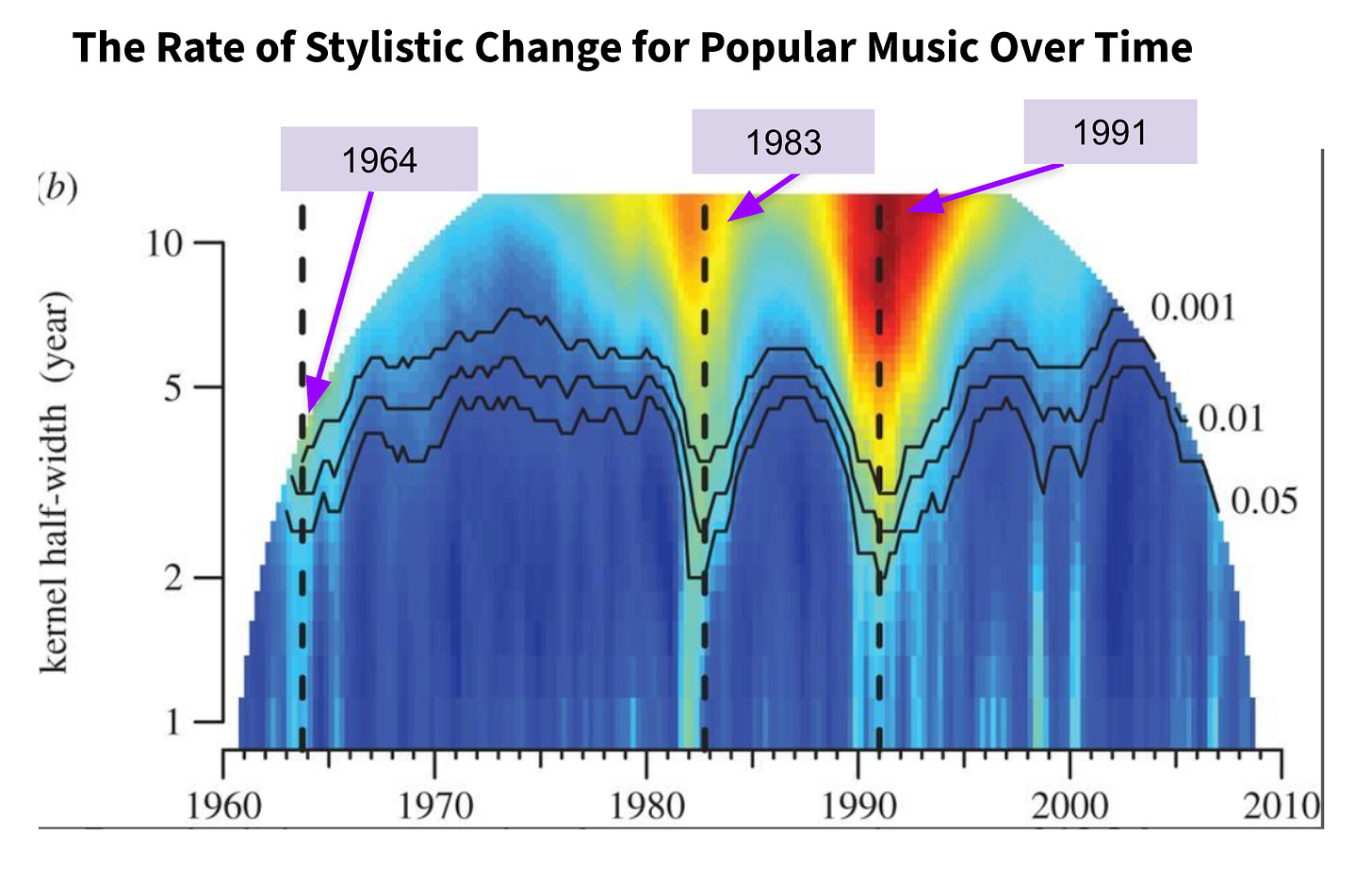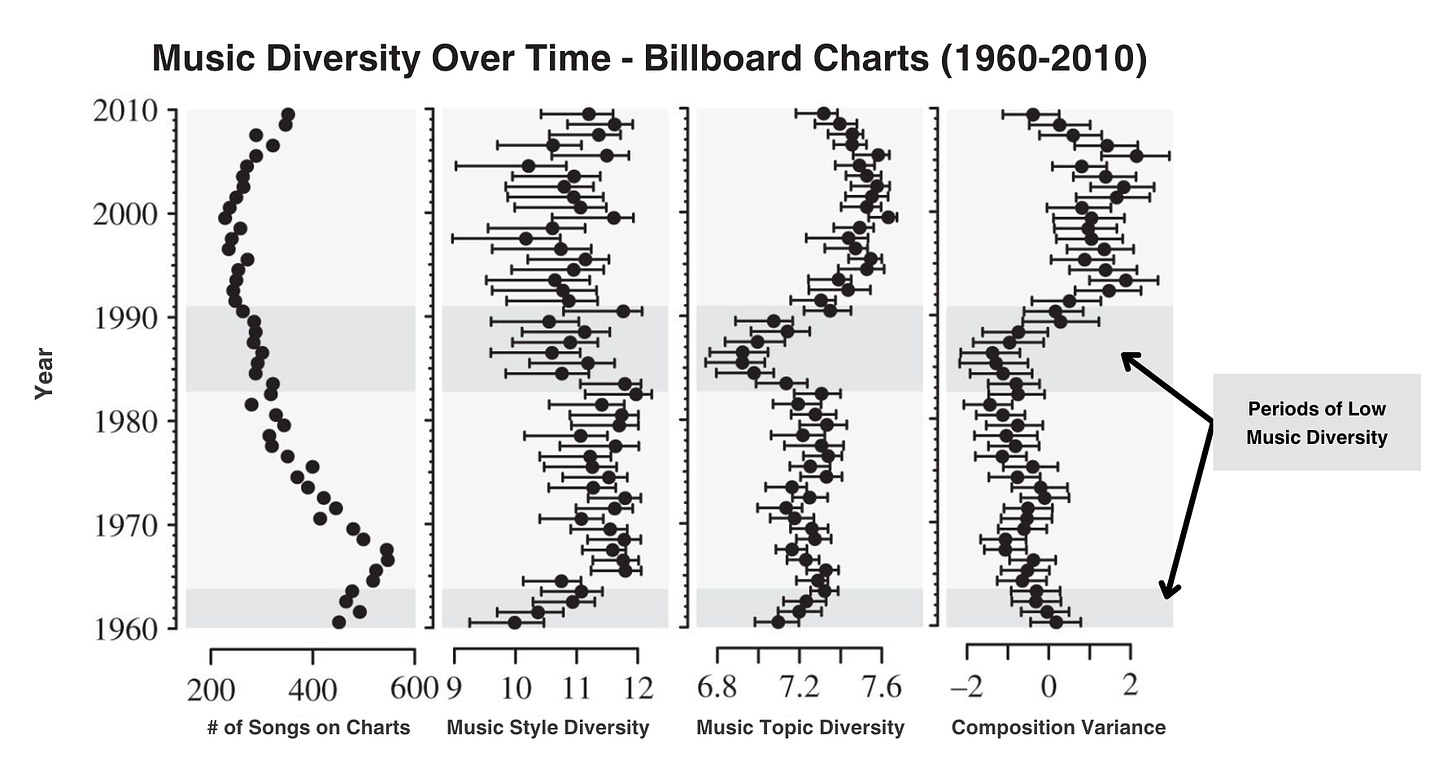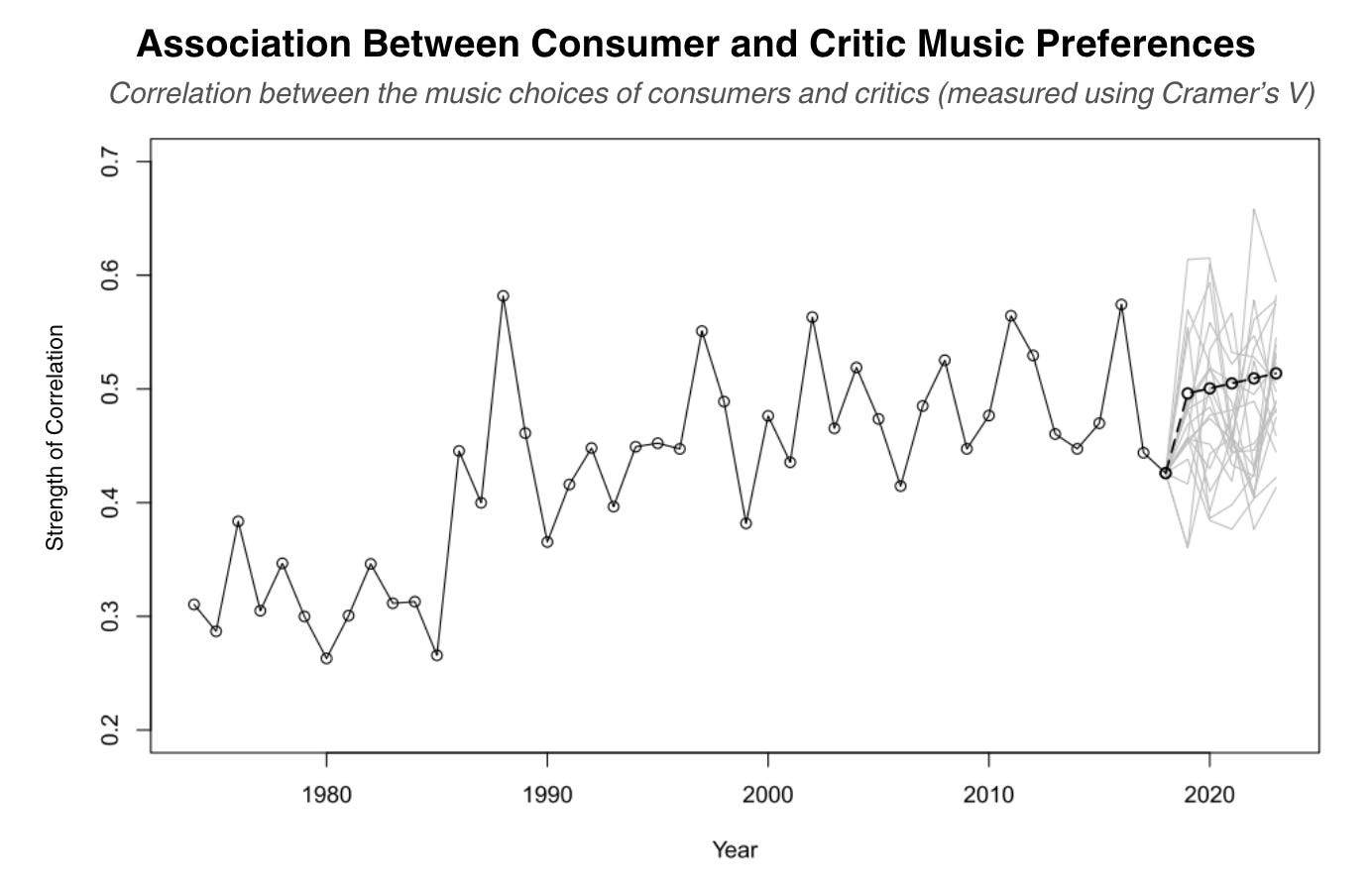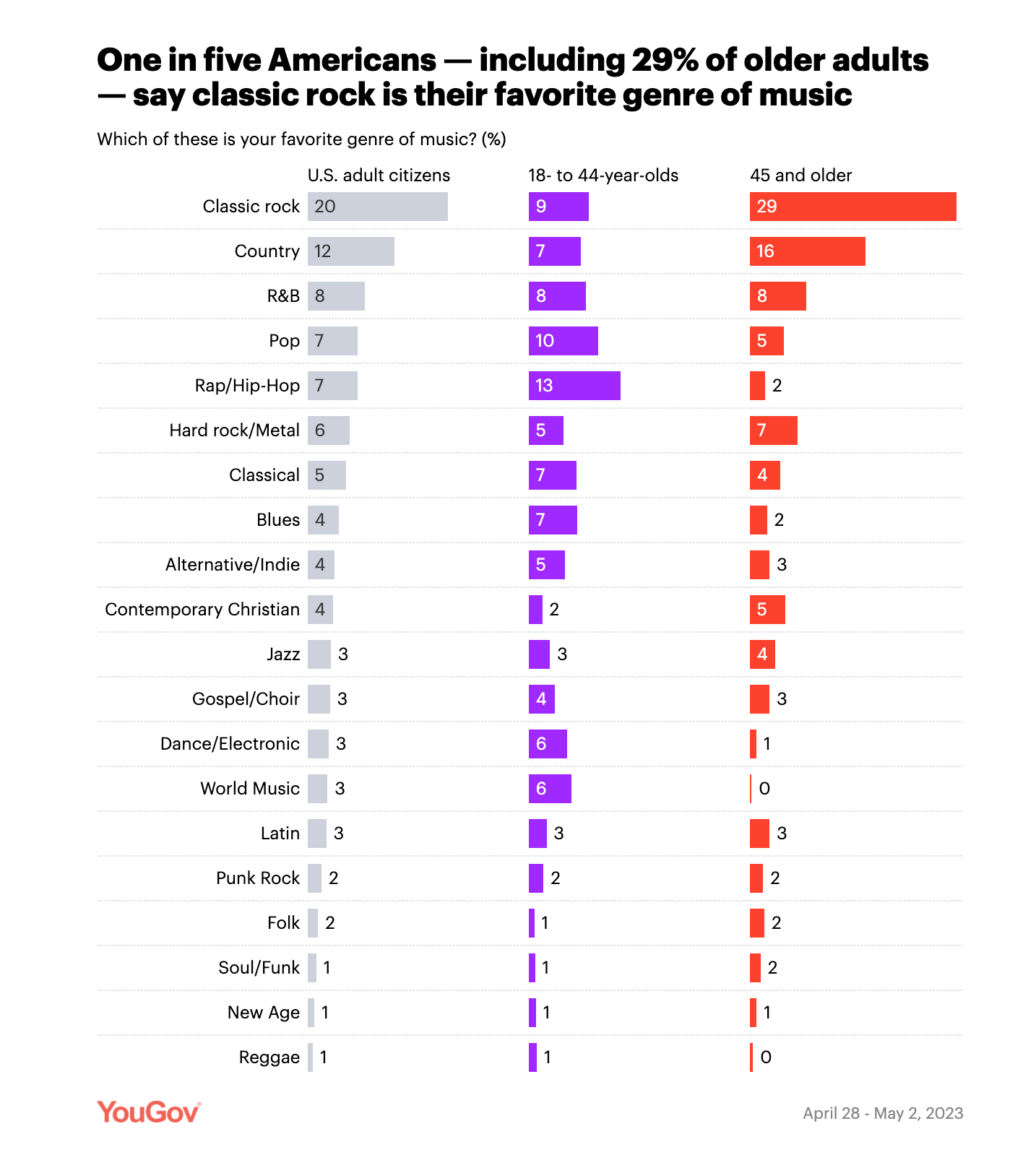- Stat Significant
- Posts
- When Did Rock & Roll Die? A Statistical Analysis
When Did Rock & Roll Die? A Statistical Analysis
When did rock fall out of the zeitgeist, and why?
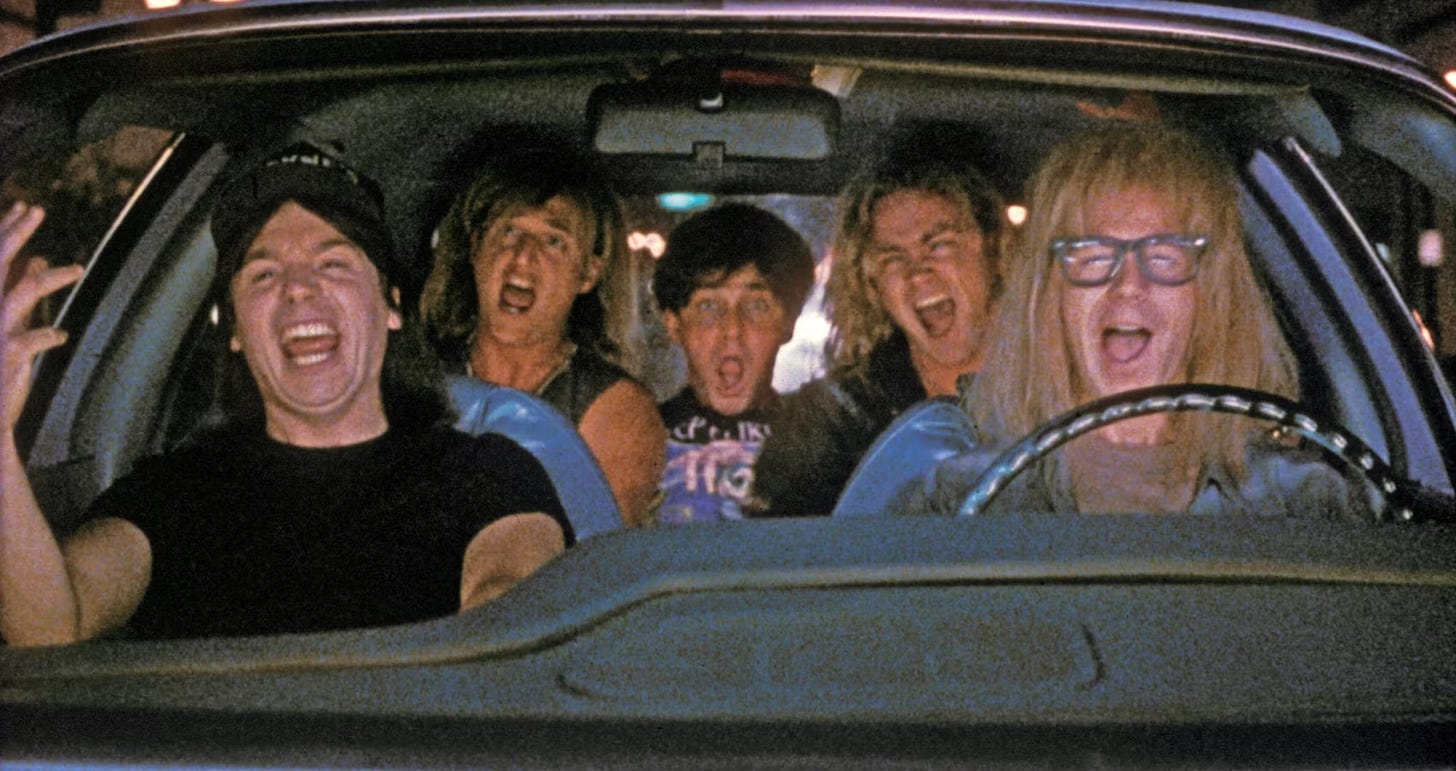
Wayne’s World (1992). Credit: Paramount Pictures.
Intro: The Death of Rock and Steak-eating
If you've maintained the gift of sound during the last decade, then you've probably heard The Lumineers' "Ho Hey." If you've somehow forgotten this song, well, it's the tune where they say the words "Ho" and "Hey" no less than fifty times. "Ho Hey" was inescapable in 2012, propelling The Lumineers to mainstream success and establishing them as the figurehead of a folk rock subgenre that includes acts like Mumford & Sons and The Head and the Heart.
Enter Alice Cooper, the 1970s shock rock pioneer and singer of classics like "School's Out" and "Poison." Cooper, never shy to offer his opinion, took exception to the rising tide of folk rock, particularly the stylings of Mumford & Songs and The Lumineers. In 2013, Cooper sat down with Fuse TV (whatever that is) and unloaded on these bands, claiming these acts did not play "real rock 'n' roll" and that their overly sentimental approach to music, featuring accordions and flutes, had no place in the genre.
It is at this point in the interview that Alice Cooper suggested these rock imposters eat steak, in a gem of a quote that could only come from a man wholly unconcerned with cancel culture:
"I just feel like this whole generation, maybe they all need to eat a steak. Maybe they need to quit eating, you know, vegetarian food and get out there and get some blood pumping in their system."
Cooper's pro-meat, anti-Lumineer rant is one of many existential pulse checks on rock & roll, a genre that has been in decline for decades (or is just straight-up dead). Throughout rock's storied history, there have been several days deemed "the end" or "death" of the art form:
1959: The plane crash that killed Buddy Holly, Ritchie Valens, and J.P. "The Big Bopper" Richardson.
1970: The Beatles break up.
1980: John Lennon's death.
1994: Nirvana frontman Kurt Cobain's death.
2012: "Ho Hey" is released.
While it's convenient to attribute rock's demise to a single event, the truth is likely more complicated. Rock may have a distinct peak, but its declining popularity is the product of numerous cultural forces.
So today, we'll pinpoint the moment when rock fell out of the zeitgeist and explore why popular culture shifted away from this musical mainstay.
When Did Rock Music Die?
Classifying music into genres involves applying objective categorizations to a subjective art form—an action worthy of countless internet debates. Is a song pop or hip-hop? Why are hip-hop and rap often classified as a single genre? Can a song be multiple genres at once?
There is a version of this analysis that devolves into a semantics nightmare where I do nothing but debate categorization criteria. To avoid a taxonomy rabbit hole, I will utilize an external dataset of Spotify genres compiled by data visualization experts at The DataFace, which categorizes over 27,000 Billboard-charting songs into 16 major genres. Is this dataset perfect? Of course not. Does a dataset of perfect genre classifications exist? Also, no.
Using DataFace song tagging, we can track the prevalence of various genres in the Billboard Top 100 over time. According to this data, rock's mainstream ascension began in the early 1960s, evolving from the similarly named "rock & roll" genre of the 1950s. What's the difference between DataFace’s "rock" and "rock & roll" classifications, you ask? Well, in the context of this dataset, "rock & roll" is an early form of rock music, known for its upbeat tempo and simple melodies (think Chuck Berry, Buddy Holly, and Elvis), while "rock" includes a broader range of styles and more complex compositions (think The Rolling Stones, Led Zeppelin, and Pink Floyd). “Rock” exploded into the mainstream in the early 1960s, fueled by Beatlemania and the so-called "British Invasion." By its peak in 1983, rock music dominated radio play and accounted for over 60% of the Billboard Top 100.
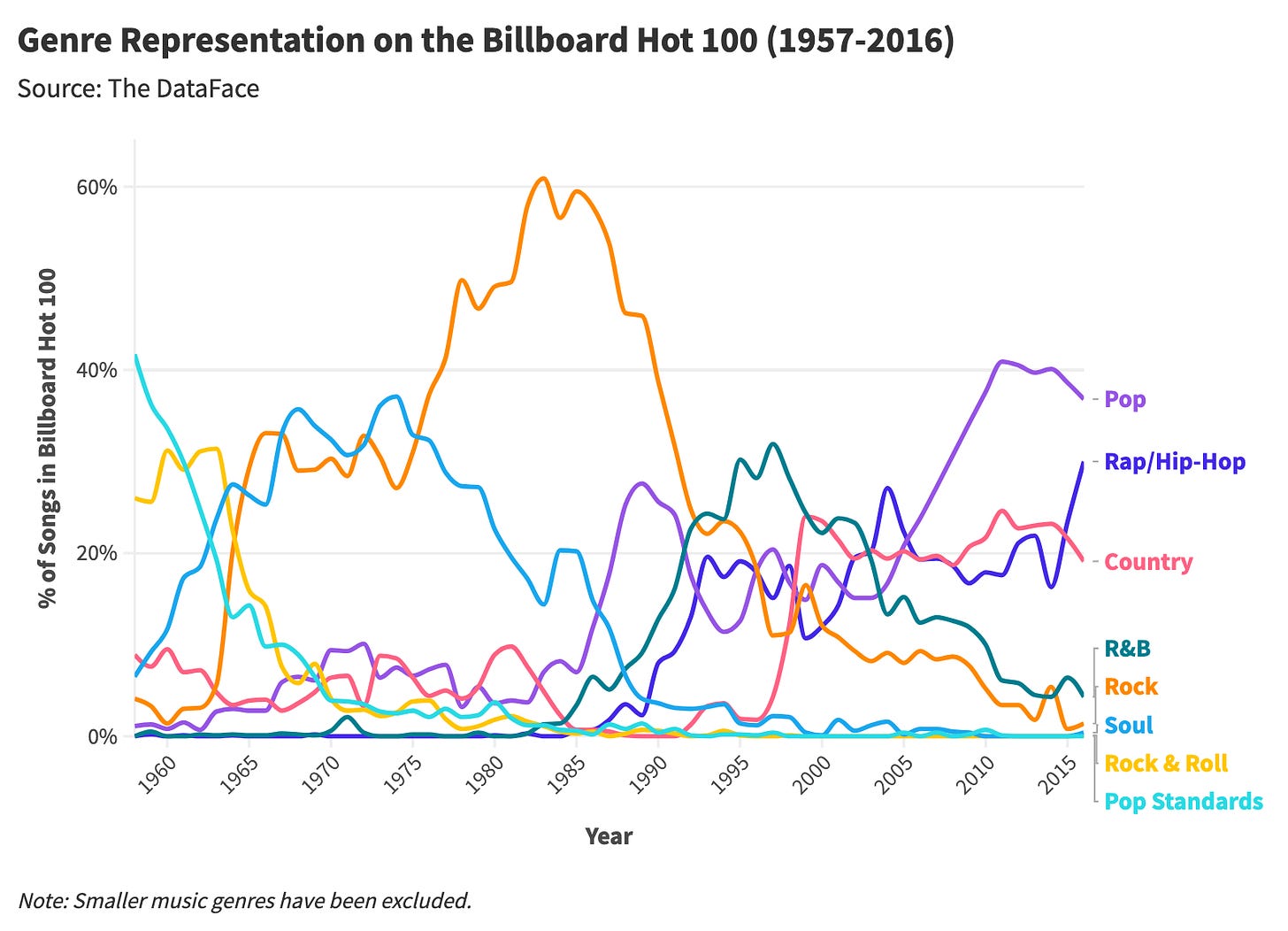
According to this data, genre popularity is cyclical, with new stylings continuously moving in and out of the mainstream. Rock & roll is replaced by rock, which is later replaced by a combination of pop, rap/hip-hop, and country. Popular tastes evolve, and genres fall out of fashion.
When we chart each genre's rise (the period when its share of the Top 100 was growing), we see that rock's monocultural reign is encapsulated within a twenty-year period starting in the early 1960s.
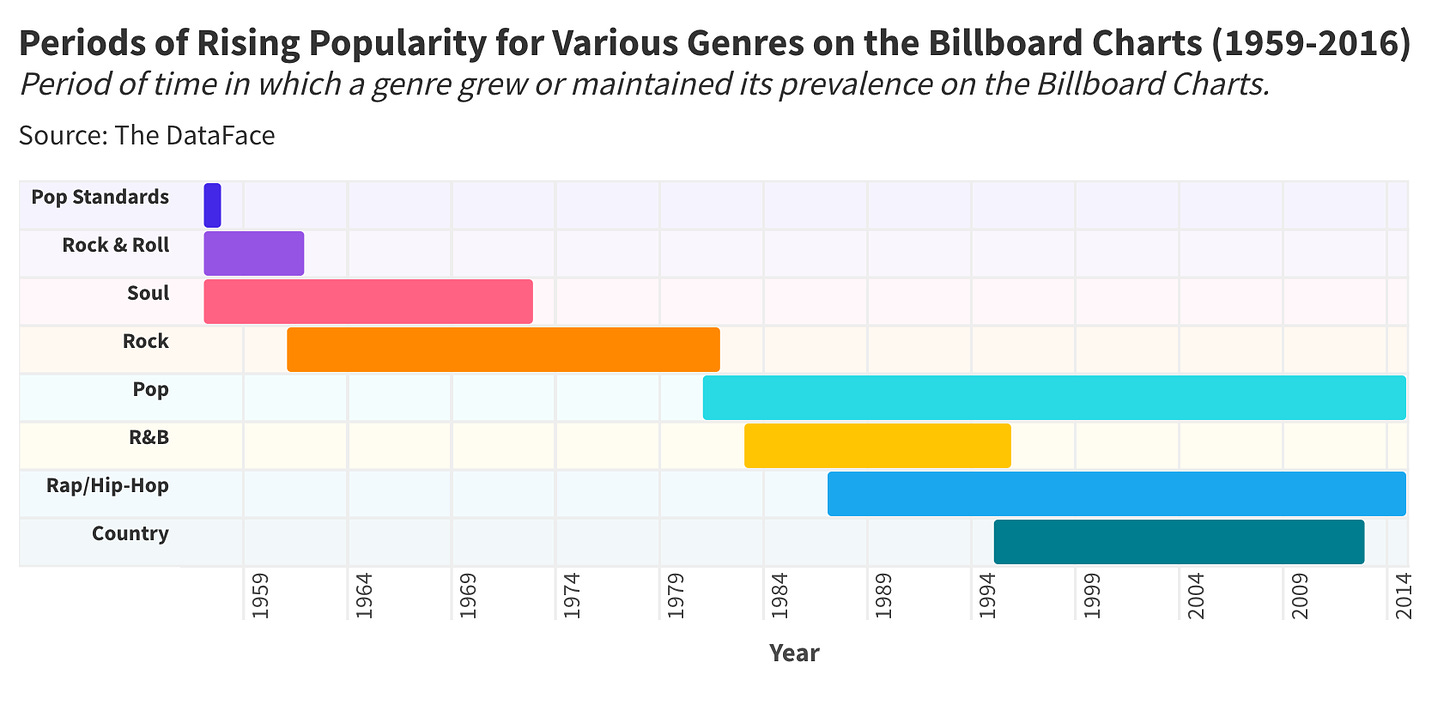
What I find most surprising about this data is the brevity of rock's cultural supremacy relative to its legacy and historical footprint. Rock's remarkable mainstream dominance—commanding a majority of Billboard's Top 100 at its peak—likely fuels intense nostalgia for the genre, idealizing an era when youth culture was rock culture.
Rock burned bright for two decades, and then it was gone, sequestered out of the mainstream. Since then, this singular genre has been rebranded as "classic rock" or (worse yet) "dad rock," while its predecessors have fragmented into subgenres such as indie, folk, and alternative.
But what caused this incomparable genre to decline? How and why did rock die? Who can we blame, if not The Lumineers?
Need Help with a Data Project?

Enjoying the article thus far and want to chat about data and statistics? Need help with a data or research project? Well, you’re in luck because Stat Significant offers data science consulting services. Reach out if you’d like to learn more!
Email [email protected]
Why Did Rock Music Die?
Music's stylistic evolution mirrors natural selection as popular sounds emerge from technological and cultural shifts. Just as genetic mutations introduce variations that become dominant in a gene pool, innovations in music can similarly spread and evolve, shaping mainstream culture.
Music history is defined by a series of distinct paradigmatic shifts, tipping points in which a cluster of stylistic changes launched a new genre or movement. Rock (not rock & roll) was born out of one of these stylistic mutations, and its eventual demise can also be traced back to one of these metamorphoses.
In a landmark study that analyzed Billboard-charting works released between 1957 and 2010, a team of British researchers found three major shifts in song composition (denoted in red, orange, and yellow in the graph below). Longtime readers may recognize this chart from a previous article on music longevity:
The research team identified three periods of musical renaissance corresponding to these inflection points:
1964 - Rock and the British Invasion: The 1964 musical revolution, highlighted by the British Invasion and The Beatles, introduced fresh songwriting styles and innovative recording techniques, including the adoption of multitrack recording. Musically, the mid- to late-1960s catalyzed the diversification of rock into sub-genres and elevated the prominence of folk and soul music, influencing broader cultural movements.
1983 - The Synth Generation: The evolution of music technology, particularly the introduction of synthesizers and drum machines, brought about this revolution. This era was characterized by a shift toward electronic music, influencing genres like new wave, synth-pop, and the early stages of hip-hop.
1991 - Rap and Hip-Hop's Rise: This year marked the mainstream breakthrough of hip-hop and rap, genres that had been growing in influence throughout the 1980s. By 1991, these styles dominated the charts, headlined by rhythmically focused and lyrically complex music.
These timeframes align with the rise of new stylings observed in DataFace's genre dataset, reflecting rock's ascension in the early 1960s and the format's demise at the hands of pop, hip-hop, and rap.
But rock didn't just get replaced by pop, rap, and hip-hop; it started falling out of favor well before this shift and, once weakened, was overtaken by emergent genres. Music consumers were likely yearning for a fresh, new sound and were rewarded with Madonna, Michael Jackson, and Wham.
Starting in the late 1970s, we can observe growing standardization among Billboard-charting songs. During this period, popular music demonstrated decreased diversity in topic, style, and composition, resulting in an increasingly homogenous sound. Sonic variety peaked in the mid-to late-1970s and bottomed out in the mid-1980s. Consequently, this period of diminished stylistic diversity is when rock acts comprised 40 to 60 percent of Billboard-charting works.
This isn't to say that all great rock acts from the late 1970s and early 1980s were formulaic, but rather, this period saw a mix of commercial overexposure and widespread imitation. Glam metal bands like Poison, Mötley Crüe, and Bon Jovi, with their gimmicks and predictable power ballads, are often seen as harbingers of the genre's decline (they were The Lumineers of their day). Their focus on flashy appearances and commercial success brought diminished stylistic diversity and reduced sonic experimentation.
The 1980s also saw the launch of MTV, shifting the music industry's focus towards "visually appealing" artists. Pop stars like Michael Jackson and Madonna, who excelled in creating visual spectacle, began dominating the charts, overshadowing rock acts incapable of matching their flashy aesthetics.
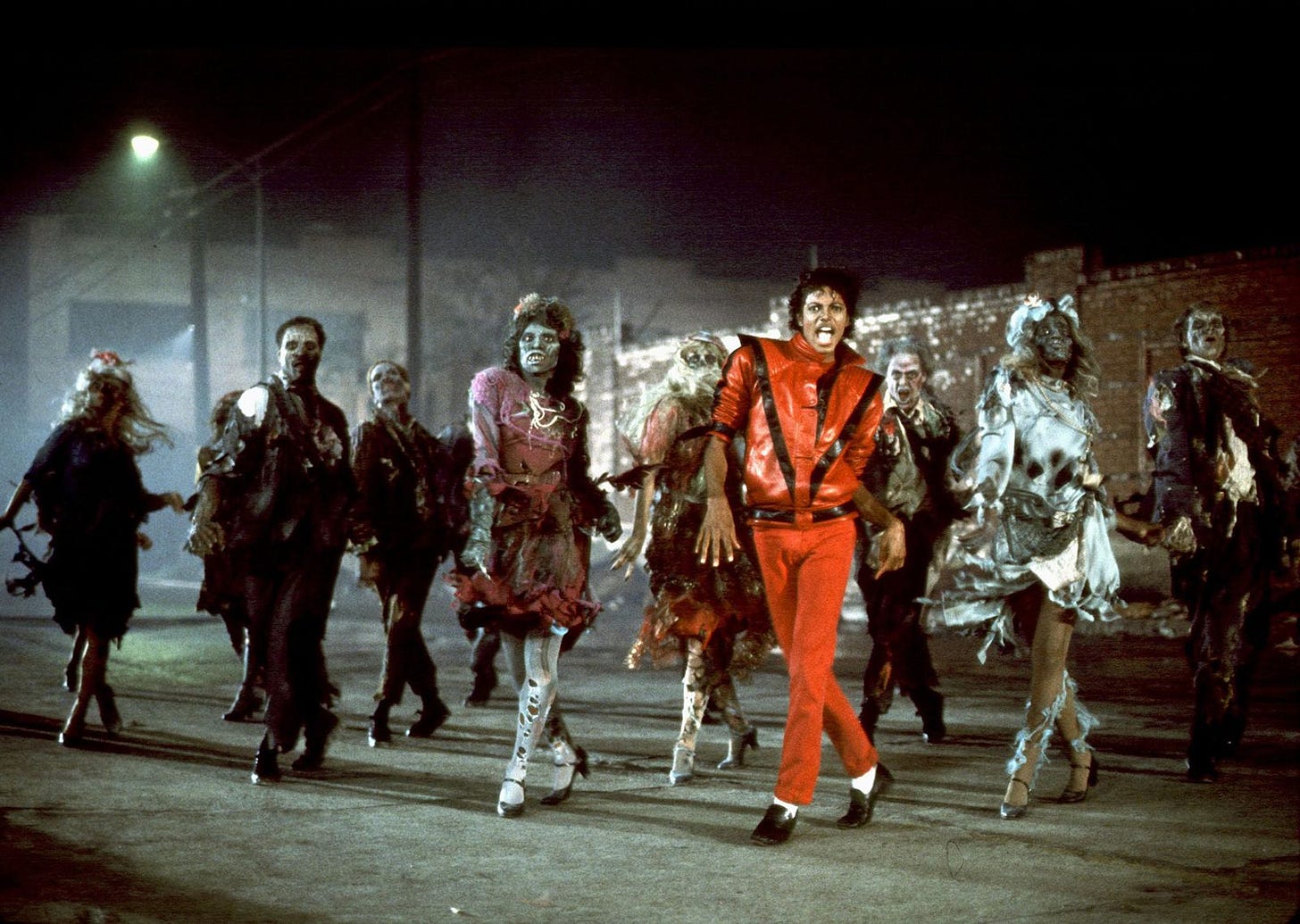
Michael Jackson’s “Thriller.” Credit: Epic Records
In many ways, the rise of pop, rap, and hip-hop can be seen as a market correction to mainstream rock's lack of cultural innovation, aesthetic appeal, and musical experimentation.
In the years leading up to the stylistic shifts of the 1980s, there was a significant disconnect between critical acclaim and consumer music preferences. However, when rock began its descent from the mainstream in the mid-1980s, the association between critic and consumer music preference rebounded and stayed aligned for the next 30 years.
Researchers attribute the critical-commercial disconnect of the late 1970s and early 1980s to widespread "rockism," an era of rock hubris that assumed perpetual relevance and dismissed other genres. During this period, critics maligned the stale output of hair metal bands and the shallow theatrics of acts like Def Leppard, Twisted Sister, and Kiss. The rise of pop, hip-hop, and rap realigned critical and commercial preferences, infusing mainstream music with new-fangled stylings and technical innovation.
The grunge movement of the 1990s, characterized by its low-fi production and anti-capitalist sentiments, is often seen as rock's last gasp at mainstream relevance. Yet there was an inherent contradiction to grunge's ascension. Artists like Nirvana's Kurt Cobain and Pearl Jam's Eddie Vedder struggled with their newfound success, which directly conflicted with their rejection of commercialism and rock stardom. The grunge movement effectively ended with Kurt Cobain's 1994 suicide, marking the decline of this ascendent subgenre and rock's best chance at a mainstream comeback.
The 21st century would see the rise of a global recording industry and the introduction of digital distribution, first through iTunes and later via streaming services like Spotify. These platforms removed the friction of physical media and the gate-keeping of major record labels: Musicians could seamlessly disseminate works in a market characterized by increased artistic control, and for $9.99 a month, users got access to every song in human history. In the 1970s, rock was one of the few genres available to music consumers, while this century has been marked by boundless choice.
YouGov polling conducted in April 2023 reveals a significant generational divide regarding genre variety. When asked to select their favorite genre, older participants' responses clustered around a few specific styles, whereas younger respondents' choices spanned a wide array of genres.
In today's music landscape, there is simply more music to choose from, making it unlikely for any single genre to achieve a 60% share of the Billboard Top 100.
When you go to Spotify's search screen, you are met with an endless grab bag of genres, subgenres, and vibes-based categorizations. Do you want to listen to "Pop," "K-pop," or "Ambient," or would you rather sample works from "Netflix," "Disney," and "Focus?"
In many ways, rock was a victim of its own success, losing its iconoclastic identity and singular hold over youth culture. Today, rock exists as a series of subgenres, tiles in a music app promoting "Indie," "Classic Rock," and "Alternative" against the likes of "Wellness," "Happy Holidays," and "Nature & Noise."
Final Thoughts: The Value of Endings
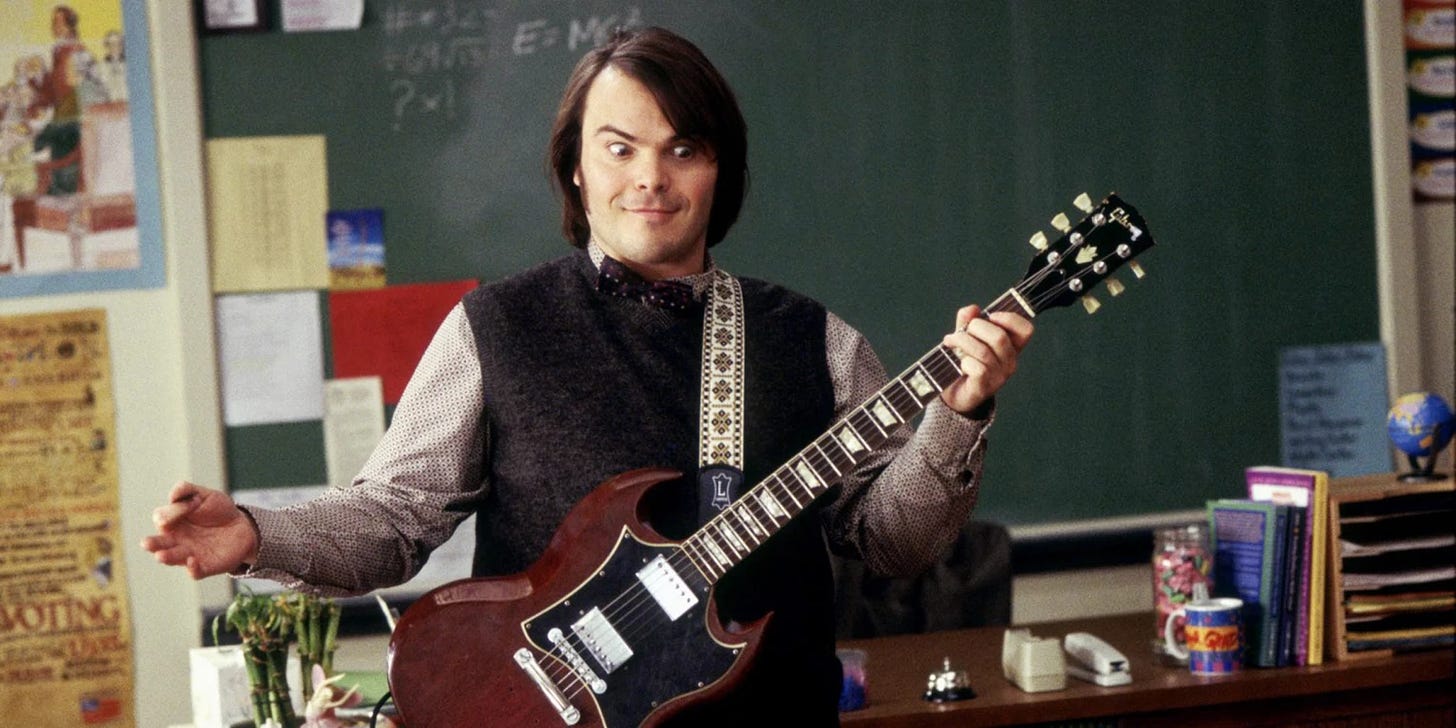
School of Rock (2004). Credit: Paramount.
While it's no fun to see a beloved band or album fade into obscurity, there may be value in finality. As a thought experiment, let's imagine an alternative history to rock's decline: What if this genre never died? What if rock remained in the zeitgeist forever? We can find the answer to this conundrum in Star Wars.
The first movie I remember seeing in theaters was Star Wars: Episode IV – A New Hope. As such, I have a deeply held affection for the original Star Wars trilogy. In 1999, George Lucas rebooted the franchise, releasing Star Wars Episode I: The Phantom Menace, and in 2012, Disney acquired the rights to this beloved media property. Now, there is no shortage of Star Wars content.
Disney's proliferation of Star Wars installments presents fans with one of two options:
Preserve Your Fandom in Amber: Let your affinity for Star Wars remain a self-contained memory, closing yourself off to future franchise installments.
Engage With New Star Wars Series and Movies: Whatever Disney makes, you watch. They have bought your fandom, but in return, you get to see an expansion of this beloved cinematic universe. Some shows and movies may be good, while others may prove frustrating.
There's nothing wrong with option 2, though many Star Wars fans seem (a little) grumpy about this unwilling Faustian bargain. Because they've chosen to love this cinematic universe (usually when they were children), they will have to watch whatever Disney+ churns out, good or bad. Star Wars will never end—the purity of this childhood fandom is now intertwined with Disney's corporate strategy. The cinematic innovation of George Lucas' 1977 classic is now a distant memory.
Can you imagine if Disney somehow gave rock music the Star Wars treatment (as absurd as it sounds)? Would we revere Led Zeppelin and Queen if these acts were still producing new music, absent many (or all) of their original members? What if the output of these zombie bands dominated Spotify's Top 40 (the product of expert corporate marketing)? I don't know about you, but I would not enjoy this. There is value in expiration dates—it's okay for culture to be rooted in a specific time and place.
Maybe it's best that rock remain outside the mainstream, allowing the genre to retain its mythological status—an iconoclastic art form whose cultural dominance is a distant memory. Or maybe rock can make a comeback, recapturing its former glory and reinvigorating the highs of Woodstock and Beatlemania—provided these new rock stars eat a lot of steak.
Thanks for reading Stat Significant! Subscribe for free to receive new posts and support my work.
Want to chat about data and statistics? Have an interesting data project? Just want to say hi? Email [email protected]
Author's Note: I acknowledge that the title of this piece refers to "rock & roll" while most of this article details the demise of the "rock" genre, as defined by DataFace's categorization.
